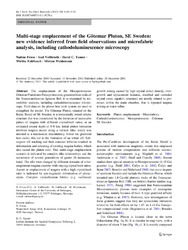Multi-stage emplacement of the Götemar Pluton, SE Sweden: new evidence inferred from field observations and microfabric analysis, including cathodoluminescence microscopy
Zeitschrift: International Journal of Earth Sciences, 2011101, 5: 1149 - 1167
DOI: https://doi.org/10.1007/s00531-011-0739-y
Persistent URL: http://resolver.sub.uni-goettingen.de/purl?gldocs-11858/6924
Persistent URL: http://resolver.sub.uni-goettingen.de/purl?gldocs-11858/6924
Friese, Nadine; Vollbrecht, Axel; Tanner, David; Fahlbusch, Wiebke; Weidemann, Miriam, 2011: Multi-stage emplacement of the Götemar Pluton, SE Sweden: new evidence inferred from field observations and microfabric analysis, including cathodoluminescence microscopy. In: International Journal of Earth Sciences, Band 101, 5: 1149 - 1167, DOI: 10.1007/s00531-011-0739-y.
 |
Dokument öffnen: |
The emplacement of the Mesoproterozoic Götemar Pluton into Paleoproterozoic granitoid host rocks of the Transscandinavian Igneous Belt is re-examined by microfabric analysis, including cathodoluminescence microscopy. Field data on the pluton-host rock system are used to strengthen the model. The Götemar Pluton, situated on the Baltic Shield of SE Sweden, is a horizontally zoned tabular structure that was constructed by the intrusion of successive pulses of magma with different crystal/melt ratios, at an estimated crustal depth of 4–8 km. Initial pluton formation involved magma ascent along a vertical dike, which was arrested at a mechanical discontinuity within the granitoid host rocks; this led to the formation of an initial sill. Subsequent sill stacking and their constant inflation resulted in deformation and reheating of existing magma bodies, which also raised the pluton roof. This multi-stage emplacement scenario is indicated by complex dike relationships and the occurrence of several generations of quartz (Si-metasomatism). The sills were charged by different domains of a heterogeneous magma chamber with varying crystal/melt ratios. Ascent or emplacement of magma with a high crystal/melt ratio is indicated by syn-magmatic deformation of phenocrysts. Complex crystallization fabrics (e.g. oscillatory growth zoning caused by high crystal defect density, overgrowth and replacement features, resorbed and corroded crystal cores, rapakivi structure) are mostly related to processes within the main chamber, that is repeated magma mixing or water influx.
Statistik:
ZugriffsstatistikSammlung:
- Geologie [933]

